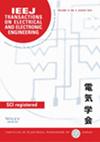Ngan Nhat Kim Nguyen, Cuong Van Anh Le, Tuan Minh Vu, Dung Quang Nguyen, Thuan Van Nguyen, Vu Trong Nguyen, Dung Huu Nguyen
求助PDF
{"title":"Determination of Shear Wave Velocity Using Multichannel Analysis of Surface Wave in M'Drak District, Dak Lak Province, Vietnam","authors":"Ngan Nhat Kim Nguyen, Cuong Van Anh Le, Tuan Minh Vu, Dung Quang Nguyen, Thuan Van Nguyen, Vu Trong Nguyen, Dung Huu Nguyen","doi":"10.1002/tee.70089","DOIUrl":null,"url":null,"abstract":"<p>Multichannel analysis of surface wave (MASW) plays a vital role in researching shallow geological structures through building their shear wave velocity models. The field phase velocity data in the frequency domain, achieved after traditionally processing field seismic data in the time–distance domain, is inverted to build the true shear velocity model. We conducted two MASW surveys to understand the geological environment at M'Drak District, Dak Lak Province, Vietnam. The results can reveal three layers with a depth of up to 30 m. In the interest area, the first layer is interpreted as loose clay soil up to 20 m deep, with its shear velocity range from 200 to 500 m/s, which can be responsible for landslides. Being considered as an extremely weathered fault rock, the second layer can have a thickness and shear wave velocity of 3–5 m and 500–800 m/s, respectively. The third one is analyzed as moderately weathered fault rock, firm, and stable thanks to its high shear wave velocity values. The MASW method helps to detect the low velocity layer that may relate to a weak soil zone. This near-surface loose clay soil in the survey area needs reinforcement before construction because of safety. Comprehensive foundation preparation work is necessary to prevent future landslides and ground subsidence. © 2025 Institute of Electrical Engineers of Japan and Wiley Periodicals LLC.</p>","PeriodicalId":13435,"journal":{"name":"IEEJ Transactions on Electrical and Electronic Engineering","volume":"20 11","pages":"1896-1900"},"PeriodicalIF":1.1000,"publicationDate":"2025-07-09","publicationTypes":"Journal Article","fieldsOfStudy":null,"isOpenAccess":false,"openAccessPdf":"","citationCount":"0","resultStr":null,"platform":"Semanticscholar","paperid":null,"PeriodicalName":"IEEJ Transactions on Electrical and Electronic Engineering","FirstCategoryId":"5","ListUrlMain":"https://onlinelibrary.wiley.com/doi/10.1002/tee.70089","RegionNum":4,"RegionCategory":"工程技术","ArticlePicture":[],"TitleCN":null,"AbstractTextCN":null,"PMCID":null,"EPubDate":"","PubModel":"","JCR":"Q4","JCRName":"ENGINEERING, ELECTRICAL & ELECTRONIC","Score":null,"Total":0}
引用次数: 0
引用
批量引用
Abstract
Multichannel analysis of surface wave (MASW) plays a vital role in researching shallow geological structures through building their shear wave velocity models. The field phase velocity data in the frequency domain, achieved after traditionally processing field seismic data in the time–distance domain, is inverted to build the true shear velocity model. We conducted two MASW surveys to understand the geological environment at M'Drak District, Dak Lak Province, Vietnam. The results can reveal three layers with a depth of up to 30 m. In the interest area, the first layer is interpreted as loose clay soil up to 20 m deep, with its shear velocity range from 200 to 500 m/s, which can be responsible for landslides. Being considered as an extremely weathered fault rock, the second layer can have a thickness and shear wave velocity of 3–5 m and 500–800 m/s, respectively. The third one is analyzed as moderately weathered fault rock, firm, and stable thanks to its high shear wave velocity values. The MASW method helps to detect the low velocity layer that may relate to a weak soil zone. This near-surface loose clay soil in the survey area needs reinforcement before construction because of safety. Comprehensive foundation preparation work is necessary to prevent future landslides and ground subsidence. © 2025 Institute of Electrical Engineers of Japan and Wiley Periodicals LLC.
越南达克省M'Drak地区面波多通道分析确定横波速度
多通道表面波分析通过建立浅层地质构造的横波速度模型,在研究浅层地质构造中起着至关重要的作用。将传统的时距域现场地震数据处理后得到的频域现场相速度数据进行反演,建立真剪切速度模型。为了了解越南达克省M'Drak地区的地质环境,我们进行了两次MASW调查。结果可以揭示三层,深度达30米。在感兴趣的区域,第一层被解释为20 m深的松散粘土,其剪切速度范围为200 - 500 m/s,可能导致山体滑坡。第二层为极端风化断层岩,其厚度可达3 ~ 5 m,横波速度可达500 ~ 800 m/s。第三层分析为中等风化断层岩,由于其高横波速度值,坚固而稳定。MASW方法有助于检测可能与弱土带有关的低速层。考虑到安全问题,该调查区近地表松散粘土在施工前需要进行加固。全面的基础准备工作是必要的,以防止未来的滑坡和地面沉降。©2025日本电气工程师协会和Wiley期刊有限责任公司。
本文章由计算机程序翻译,如有差异,请以英文原文为准。


 求助内容:
求助内容: 应助结果提醒方式:
应助结果提醒方式:


